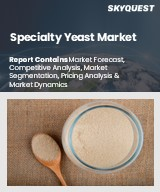
세계의 특수 효모 시장 규모는 2023년 73억 3,000만 달러로 평가되었으며, 2024년 78억 2,000만 달러에서 2032년까지 131억 4,000만 달러에 이르고, 예측 기간(2025-2032년) 중 CAGR 6.7%의 성장이 예측됩니다.
세계의 특수 효모 시장은 식품 및 베이커리 분야의 진보에 가세해 크래프트 음료나 혁신적인 양조장에 대한 수요가 높아지는 등의 동향에 의해 견인되어 현저한 성장을 이루고 있습니다. 독특하고 고품질의 식품 및 음료에 대한 소비자의 기호는 기능적이고 다양한 효모 품종에 대한 요구를 부추기고 있습니다. 크래프트 맥주와 콤부차를 포함한 소량 생산 음료의 인기는 풍미와 식감을 향상시키는 다양한 효모 균주의 탐구를 생산자에게 촉진하고 시장 확대를 촉진하고 있습니다. 베이커리 및 식품업계에서는 특수 효모는 영양적 및 기능적인 이점이 평가되고 있으며, 특히 가공식품 수요가 증가하고 있는 신흥 시장에서는 그 가치가 인정되고 있습니다. 그러나 높은 생산 비용, 엄격한 규제, 신흥 국가 시장에서 소비자의 의식이 낮고 저렴한 대체품과의 경쟁과 같은 문제는 향후 시장 성장을 방해할 수 있습니다.
Global Speciality Yeast Market size was valued at USD 7.33 Billion in 2023 and is poised to grow from USD 7.82 Billion in 2024 to USD 13.14 Billion by 2032, growing at a CAGR of 6.7% during the forecast period (2025-2032).
The global specialty yeast market is experiencing notable growth driven by trends such as the rising demand for craft beverages and innovative breweries, alongside advancements in food and bakery sectors. Consumer preferences for unique, high-quality food and drink are fueling the need for functional and diverse yeast varieties. The popularity of small-batch beverages, including craft beer and kombucha, is leading producers to explore various yeast strains that enhance flavors and textures, thus propelling market expansion. In the bakery and food industries, specialty yeast is valued for its nutritional and functional benefits, especially in emerging markets with increasing demand for processed foods. However, challenges like high production costs, stringent regulations, limited consumer awareness in developing regions, and competition from cheaper substitutes could hinder future market growth.
Top-down and bottom-up approaches were used to estimate and validate the size of the Speciality Yeast market and to estimate the size of various other dependent submarkets. The research methodology used to estimate the market size includes the following details: The key players in the market were identified through secondary research, and their market shares in the respective regions were determined through primary and secondary research. This entire procedure includes the study of the annual and financial reports of the top market players and extensive interviews for key insights from industry leaders such as CEOs, VPs, directors, and marketing executives. All percentage shares split, and breakdowns were determined using secondary sources and verified through Primary sources. All possible parameters that affect the markets covered in this research study have been accounted for, viewed in extensive detail, verified through primary research, and analyzed to get the final quantitative and qualitative data.
Global Speciality Yeast Market Segments Analysis
Global Speciality Yeast Market is segmented by product type, application, strain type, distribution channel, end-user industry and region. Based on product type, the market is segmented into baker's yeast, brewer's yeast, distiller's yeast, and feed yeast. Based on application, the market is segmented into baking, brewing, distilling, animal feed and pharmaceuticals. Based on distribution channel, the market is segmented into direct sales, retail stores, industrial suppliers and online marketplaces. Based on the end-user industry, the market is segmented into food beverage, pharmaceuticals nutraceuticals, animal feed and agriculture. Based on region, the market is segmented into North America, Europe, Asia Pacific, Latin America and the Middle East and Africa.
Driver of the Global Speciality Yeast Market
The rising demand for craft beverages, including craft beer, kombucha, seltzer, and other specialty drinks, is significantly driving the growth of the specialty yeast market. These beverages rely on distinctive yeast strains, such as Saccharomyces Pastorianus, to develop the unique flavors, aromas, and textures that distinguish various traditional and contemporary drinks. As consumers prioritize premium and flavorful drinking experiences, there is a noticeable shift towards customized, high-quality fermentation methods. This trend is accelerating the adoption of specialty yeast, as manufacturers strive to meet the evolving preferences of consumers who are increasingly interested in exploring diverse and complex flavor profiles in their beverages.
Global Restraints in the Speciality Yeast Market
The production of specialty yeast entails advanced fermentation techniques and a customized environment, along with specific raw materials, which collectively drive up production costs. These elevated operating expenses can pose significant barriers to market entry, particularly for small and medium-sized food or feed manufacturers with tighter budgets. Furthermore, the price sensitivity prevalent in developing regions complicates the broader acceptance and implementation of specialty yeast products. Consequently, these factors create potential restraints within the specialty yeast market, limiting opportunities for smaller players and hindering growth in areas where cost considerations are paramount.
Market Trends of the Global Speciality Yeast Market
The global specialty yeast market is witnessing a significant upward trend, driven by heightened consumer demand for a variety of bread products, including artisanal rolls, pasta, and sandwiches, particularly in the Asia-Pacific region. Concurrently, the booming growth of the alcoholic beverages sector, encompassing beer and wine production, further fuels this expansion. As health-conscious consumers gravitate towards natural and high-quality ingredients, specialty yeasts are increasingly recognized for their role in enhancing flavor, texture, and nutritional value in both baked goods and alcoholic beverages. This confluence of factors underscores a robust market outlook for specialty yeast, catering to evolving consumer preferences and culinary innovations.